最近很多朋友,都在关注阿里公测的“通义灵码”,我索性也安装了,准备看看它真的有说的那么“灵吗”?

一、安装
官网:https://tongyi.aliyun.com/lingma/
安装方式:https://tongyi.aliyun.com/lingma/download
帮助手册:https://help.aliyun.com/document_detail/2590613.html
补充几个安装步骤:
1、我用的是IDEA,各位IDEA的小伙伴要注意从插件商店去安装,搜索“TONGYI Lingma”。

2、安装完成后要重启,重启后可能会有一定的加载过程,比较慢。

3、重启后,IDEA会提示你灵码要登录。


4、点击登录后会进入阿里云登录界面,登录自己的阿里账号。

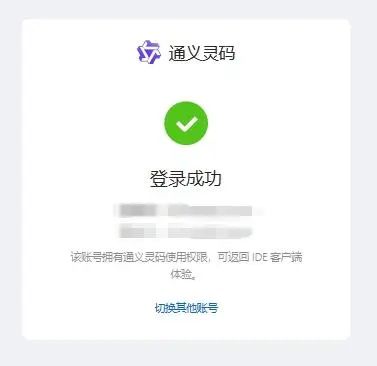

5、登录成功后,可以看看右边的栏目中找到“通义灵码”的插件,点击后即可对话。
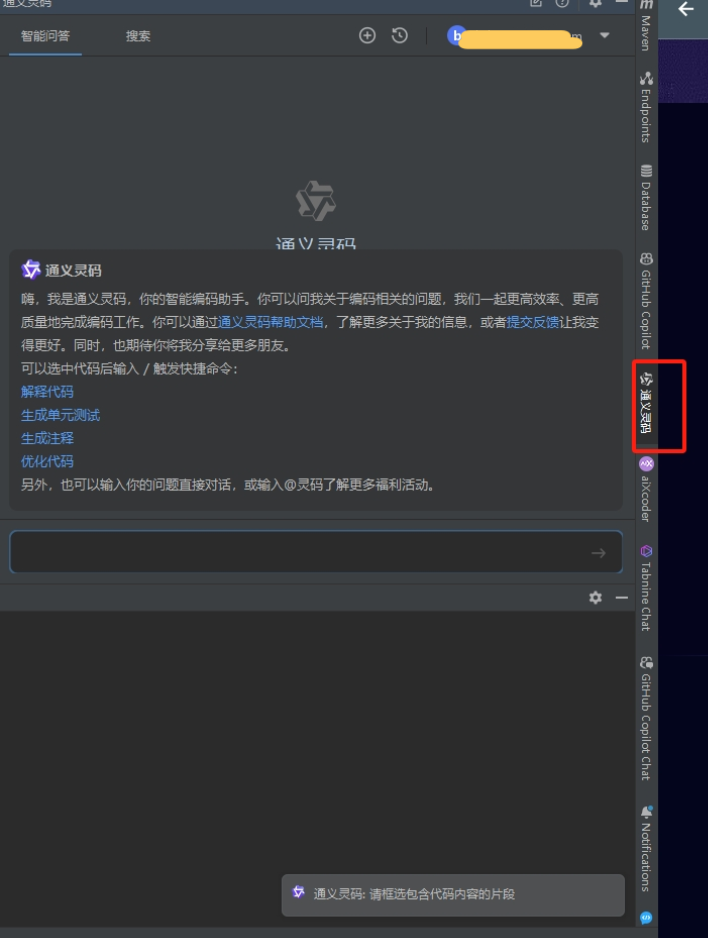
6、快捷键。
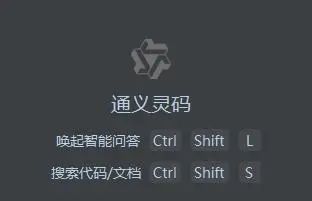
二、初探
一)看看聊闲话的能力
安装这个的目的就是为了让它帮咱们写代码,现在一起来看看他写代码的能力,首先我尝试的问了一些题外话:
1、开发团队的问题
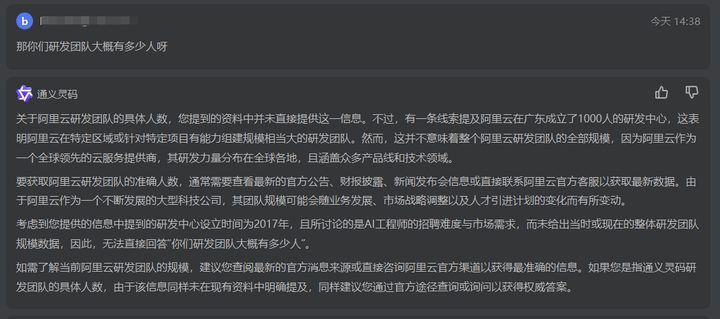
回答很官方,哈哈。
2、看看它会多少种语言
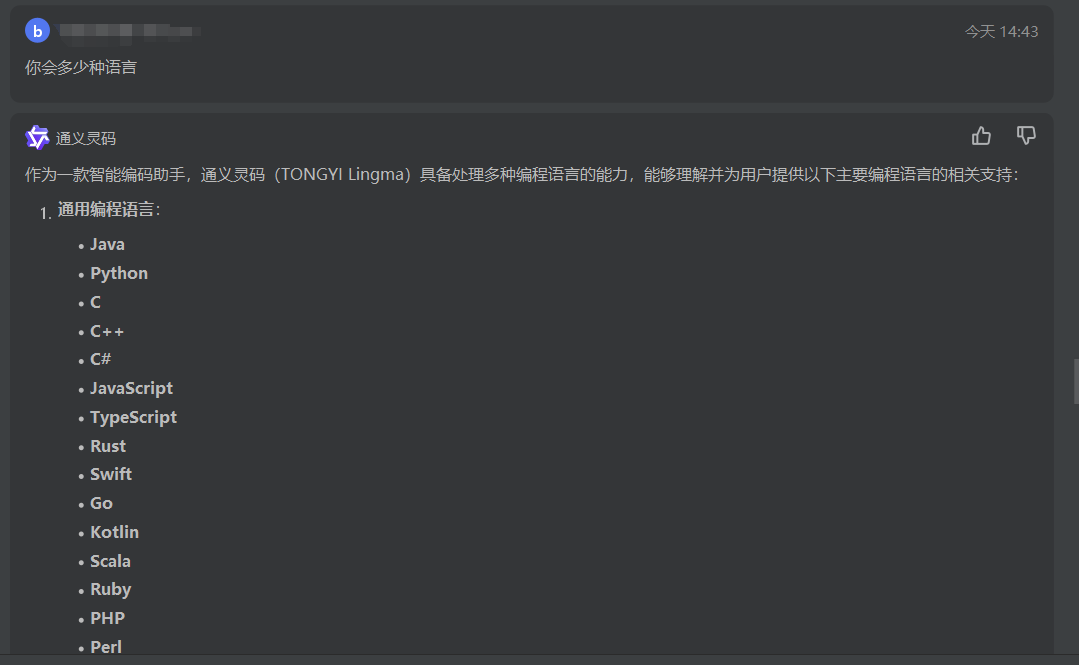
由于截图有限我把他的内容整理出来,能明确的是102种:
作为一款智能编码助手,通义灵码(TONGYI Lingma)具备处理多种编程语言的能力,能够理解并为用户提供以下主要编程语言的相关支持:
通用编程语言:
Java、Python、C、C++、C#、JavaScript、TypeScript、Rust、Swift、Go、Kotlin、Scala、Ruby、PHP、Perl、Objective-C、Dart、Erlang、Haskell、Lua、Julia、Groovy、R、Matlab
Web开发相关:
HTML/CSS、React、Vue.js、Angular、Svelte、jQuery、Bootstrap、Tailwind CSS、Webpack、Gatsby、Next.js、Nuxt.js、Jekyll、WordPress、Drupal、Laravel、Django、Flask、Express.js、Fastify、Node.js
移动开发:
Android (Java/Kotlin)、iOS (Swift/Objective-C)、Flutter、React Native
数据库与数据处理:
SQL (MySQL, PostgreSQL, SQLite, Oracle, SQL Server, etc.)、
NoSQL (MongoDB, Cassandra, Redis, Elasticsearch, etc.)、
GraphQL、Pandas、NumPy、SciPy、pandas-SQLAlchemy、dplyr (R)
脚本与自动化:
Bash、PowerShell、Ansible、Terraform、Chef、Puppet
数据分析与科学计算:
NumPy、Pandas、SciPy、Matplotlib、Seaborn、scikit-learn、TensorFlow、PyTorch、Keras、Theano、Spark MLlib、R Shiny
云计算与容器化:
Docker、Kubernetes、AWS SDKs、Azure SDKs、Google Cloud SDKs、OpenStack、Terraform、CloudFormation
其他工具与框架:
Git、Jenkins、Travis CI、CircleCI、GitHub Actions、Docker Compose、Makefiles、JUnit、pytest、Mocha、Chai、Jest、Enzyme、ESLint、Prettier、Black、Flake8、SonarQube、Jupyter Notebook
以上列举了通义灵码能够提供支持的部分编程语言、框架、库和服务。
3、是否能判断我当前的代码环境和开发环境
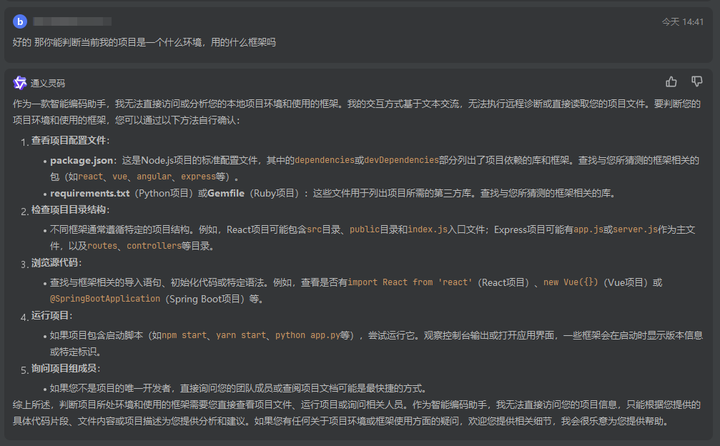
嗯~意料之中吧。
三、看看发力点
一)代码补全
直接上干货,我在service中增加了一个方法,只给它把注释写好,让他来补写代码:
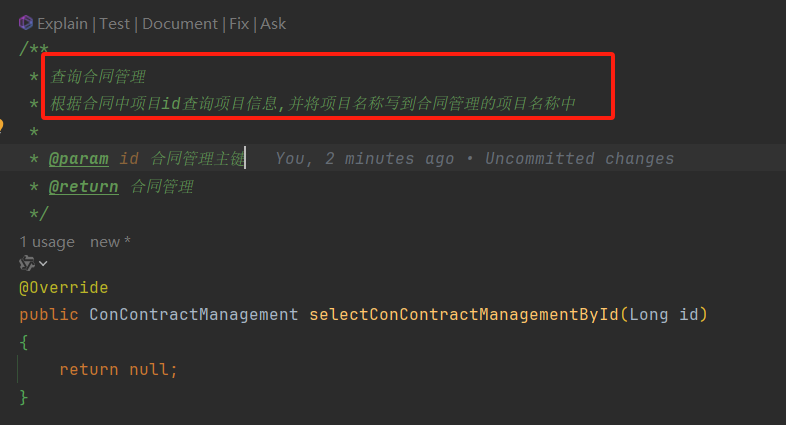
组合键ALT + P:
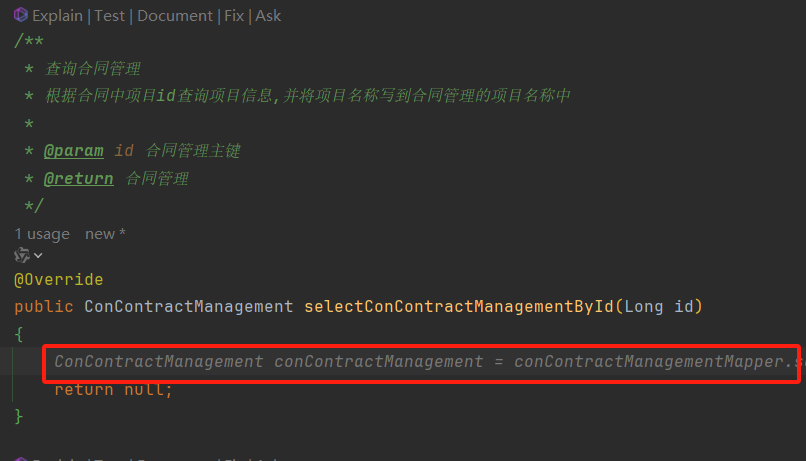
Tab键将代码做实,回车后会自动提示下面的代码:
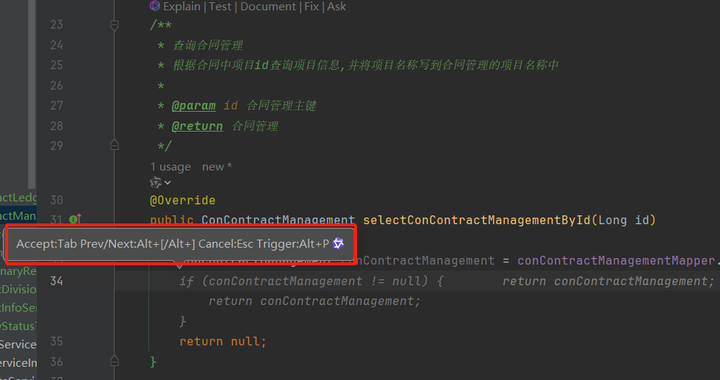
但是显然还没完成,我们在方法中间再让它补充一下:
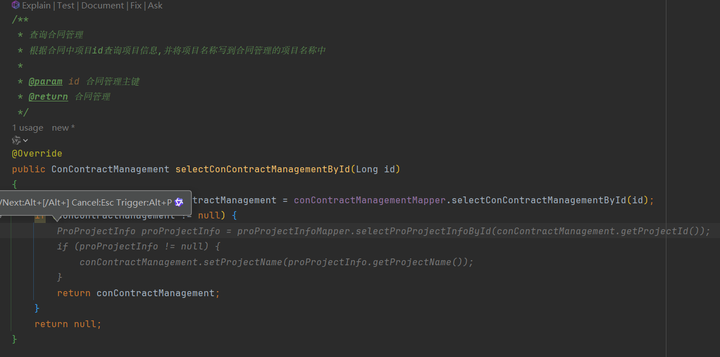
这次就完美了,哈哈总体来说,简单的代码还是可以写的。
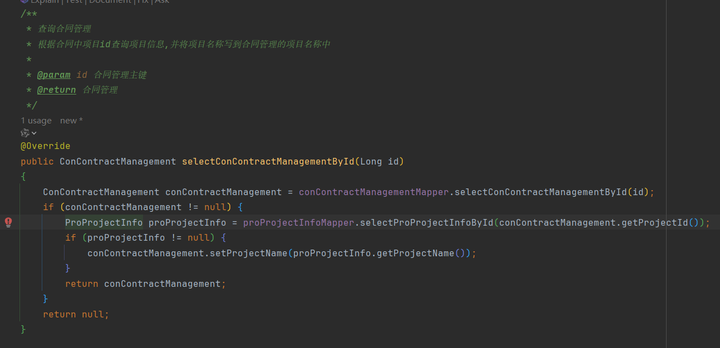
二)再看看查问题的能力
1、直白问题查找

回答挺全面的,因为问题就很模糊,回答自不用说了。
三)选中代码进行bug查找
选中左边的文件认为有问题的代码,在右边的对话框中填入“/查找问题”,回车。
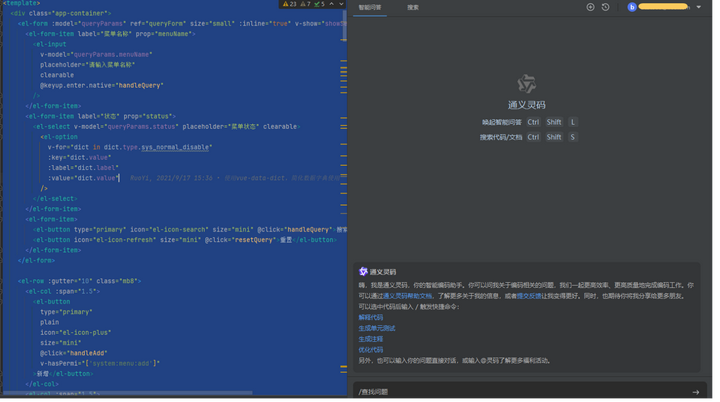


从这些原因中进行分析和查找,多半能解决。
四)对问题进行搜索
解答大多数来自“stackoverflow”
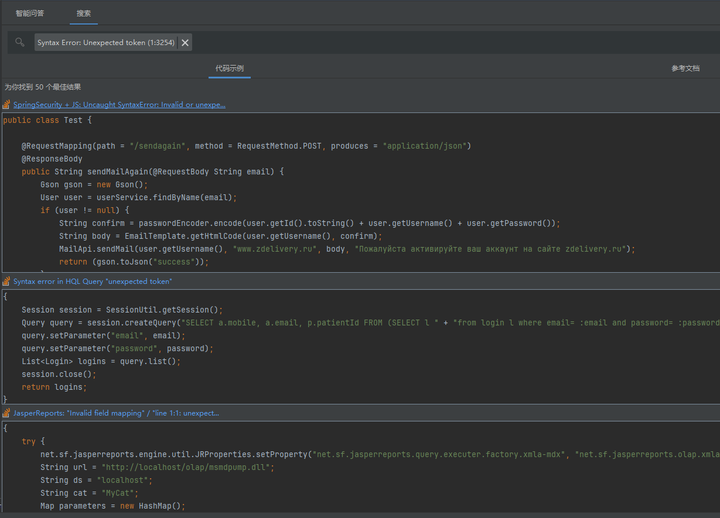
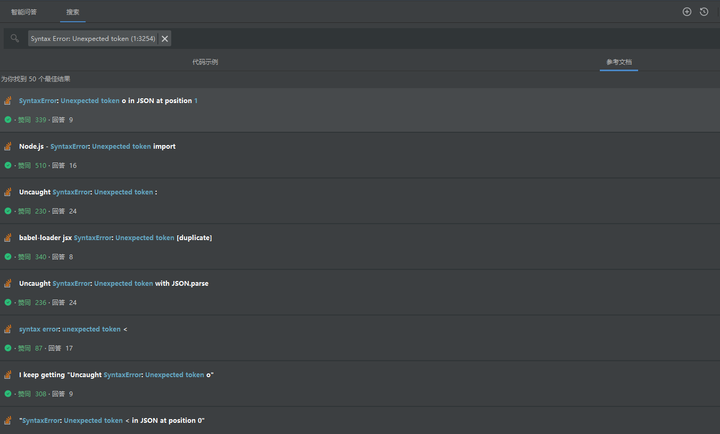
四、尝试让他写个增删改查
下面我以Java为例,用rouyi框架做演示,让它来写一个增删改查试试:
一)先写Controller
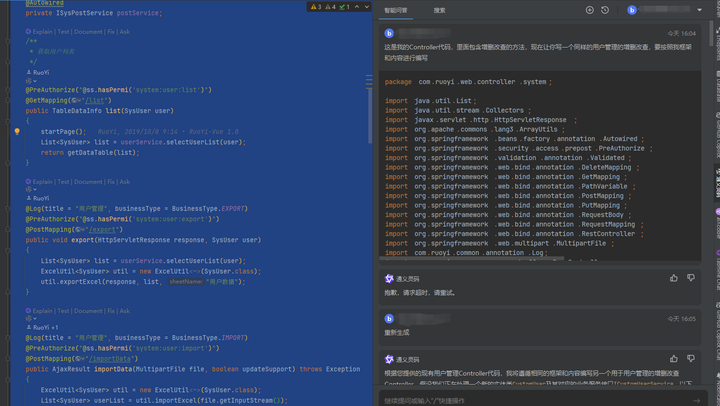
package com.example.app.controller.system;
import java.util.List;
import java.util.stream.Collectors;
import javax.servlet.http.HttpServletResponse;
import org.apache.commons.lang3.ArrayUtils;
import org.springframework.beans.factory.annotation.Autowired;
import org.springframework.security.access.prepost.PreAuthorize;
import org.springframework.validation.annotation.Validated;
import org.springframework.web.bind.annotation.DeleteMapping;
import org.springframework.web.bind.annotation.GetMapping;
import org.springframework.web.bind.annotation.PathVariable;
import org.springframework.web.bind.annotation.PostMapping;
import org.springframework.web.bind.annotation.PutMapping;
import org.springframework.web.bind.annotation.RequestBody;
import org.springframework.web.bind.annotation.RequestMapping;
import org.springframework.web.bind.annotation.RestController;
import org.springframework.web.multipart.MultipartFile;
import com.example.app.common.annotation.Log;
import com.example.app.common.core.controller.BaseController;
import com.example.app.common.core.domain.AjaxResult;
import com.example.app.common.core.domain.entity.CustomUser;
import com.example.app.common.enums.BusinessType;
import com.example.app.common.utils.SecurityUtils;
import com.example.app.common.utils.StringUtils;
import com.example.app.common.utils.poi.ExcelUtil;
import com.example.app.system.service.ICustomUserService;
/**
* 自定义用户信息
*
* @author Your Name
*/
@RestController
@RequestMapping("/system/customuser")
public class CustomUserController extends BaseController
{
@Autowired
private ICustomUserService customUserService;
/**
* 获取自定义用户列表
*/
@PreAuthorize("@ss.hasPermi('system:customuser:list')")
@GetMapping("/list")
public TableDataInfo list(CustomUser customUser)
{
startPage();
List<CustomUser> list = customUserService.selectCustomUserList(customUser);
return getDataTable(list);
}
@Log(title = "自定义用户管理", businessType = BusinessType.EXPORT)
@PreAuthorize("@ss.hasPermi('system:customuser:export')")
@PostMapping("/export")
public void export(HttpServletResponse response, CustomUser customUser)
{
List<CustomUser> list = customUserService.selectCustomUserList(customUser);
ExcelUtil<CustomUser> util = new ExcelUtil<CustomUser>(CustomUser.class);
util.exportExcel(response, list, "自定义用户数据");
}
// ... (省略导入功能相关方法,若需要请自行添加)
/**
* 根据自定义用户ID获取详细信息
*/
@PreAuthorize("@ss.hasPermi('system:customuser:query')")
@GetMapping(value = { "/", "/{customUserId}" })
public AjaxResult getCustomUserInfo(@PathVariable(value = "customUserId", required = false) Long customUserId)
{
if (StringUtils.isNotNull(customUserId))
{
CustomUser customUser = customUserService.selectCustomUserById(customUserId);
return AjaxResult.success(customUser);
}
return AjaxResult.error("Invalid custom user ID");
}
/**
* 新增自定义用户
*/
@PreAuthorize("@ss.hasPermi('system:customuser:add')")
@Log(title = "自定义用户管理", businessType = BusinessType.INSERT)
@PostMapping
public AjaxResult add(@Validated @RequestBody CustomUser customUser)
{
if (!customUserService.checkCustomUserNameUnique(customUser))
{
return error("新增自定义用户'" + customUser.getUserName() + "'失败,登录账号已存在");
}
// ... (根据实际需求添加其他唯一性校验,如手机号、邮箱等)
customUser.setCreateBy(getUsername());
// ... (如有需要,进行密码加密或其他初始化操作)
return toAjax(customUserService.insertCustomUser(customUser));
}
/**
* 修改自定义用户
*/
@PreAuthorize("@ss.hasPermi('system:customuser:edit')")
@Log(title = "自定义用户管理", businessType = BusinessType.UPDATE)
@PutMapping
public AjaxResult edit(@Validated @RequestBody CustomUser customUser)
{
customUserService.checkCustomUserAllowed(customUser);
if (!customUserService.checkCustomUserNameUnique(customUser))
{
return error("修改自定义用户'" + customUser.getUserName() + "'失败,登录账号已存在");
}
// ... (根据实际需求添加其他唯一性校验,如手机号、邮箱等)
customUser.setUpdateBy(getUsername());
return toAjax(customUserService.updateCustomUser(customUser));
}
/**
* 删除自定义用户
*/
@PreAuthorize("@ss.hasPermi('system:customuser:remove')")
@Log(title = "自定义用户管理", businessType = BusinessType.DELETE)
@DeleteMapping("/{customUserIds}")
public AjaxResult remove(@PathVariable Long[] customUserIds)
{
if (ArrayUtils.contains(customUserIds, getUserId()))
{
return error("当前用户不能删除");
}
return toAjax(customUserService.deleteCustomUserByIds(customUserIds));
}
// ... (省略其他自定义用户管理相关功能,如重置密码、状态修改、授权等,若需要请自行添加)
/**
* 获取自定义用户所属部门树列表
*/
@PreAuthorize("@ss.hasPermi('system:customuser:list')")
@GetMapping("/deptTree")
public AjaxResult customUserDeptTree(CustomUser customUser)
{
// ... (实现或调用相应服务方法获取自定义用户的部门树列表)
return success(customUserDeptTreeList);
}
}代码还不错,基本满足要求,接下来我给它数据表的sql,告诉它用ORM用的MyBatis,让他生成domain文件、service层文件、mapper文件和xml文件,结果就差强人意了:
二)domain
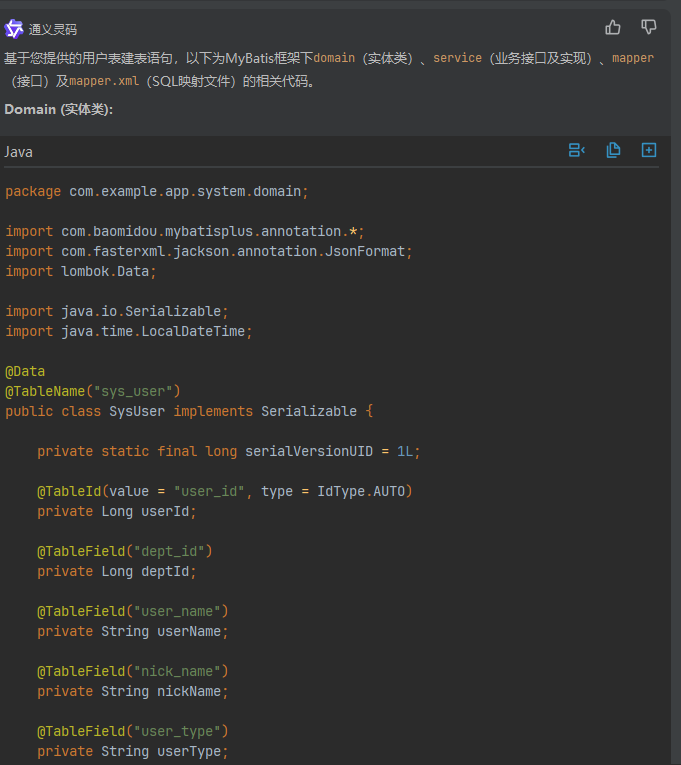
三)service
有点拉跨,想使用就得不停的连续问
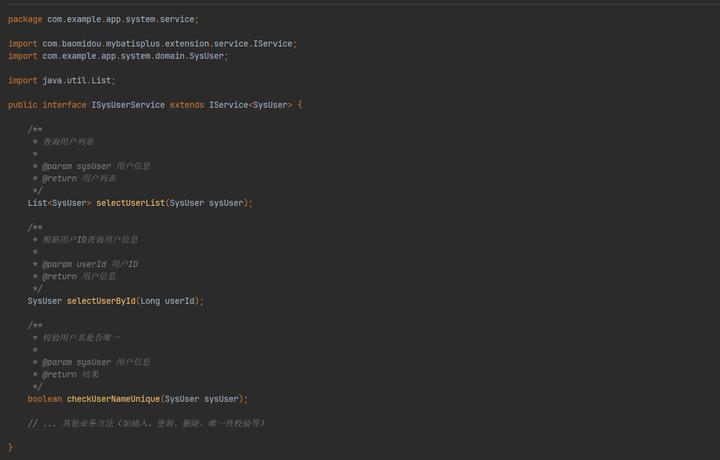
四)Mapper
直接给了个空接口

五)XML
应该是回答字数限制,突然停止了,然后我让它“继续”。。。。
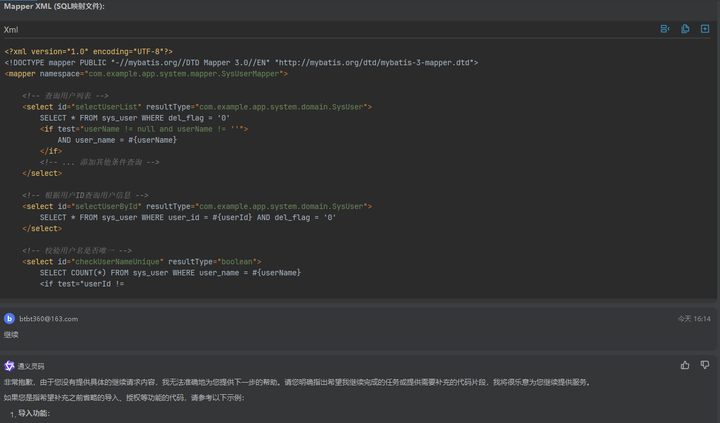
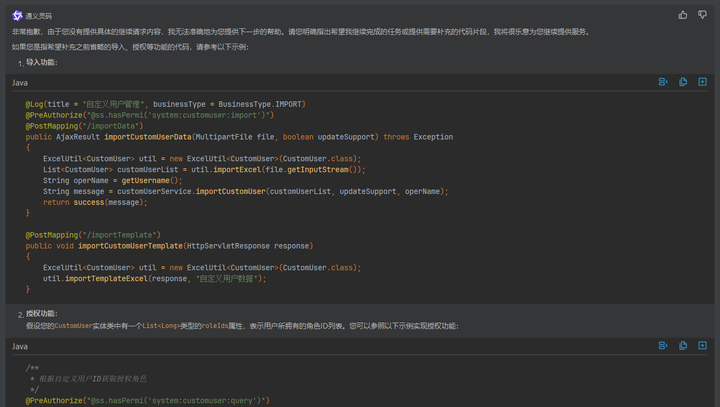
嗯~~~~它开始别的操作了,应该是上下文衔接不好。
综合看,不如代码生成器来的方便,能节约开发量吗,能节约,但不是很大,没那么玄乎。
五、它适合来干啥?
1、简单的代码补全,前提是你能够有逻辑能力,有清晰的判断,并且告诉它,你会引入其他类或方法来辅助它。
2、查找明显错误(逻辑性强的难点儿)
3、生成固定写法和算法
例如这样的:
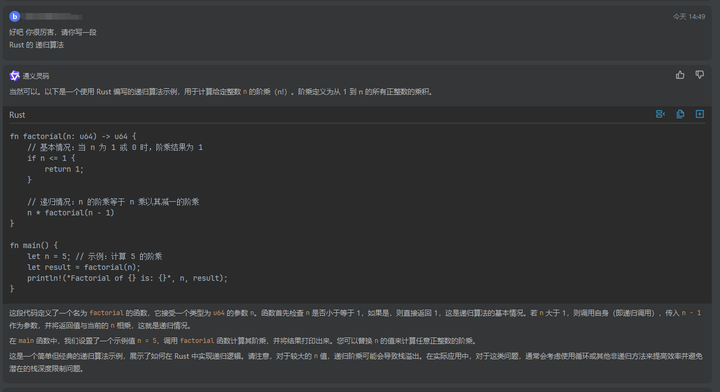
4、生成注释和解释代码
六、总结
总的来说,灵码还是挺灵的,但是如果想从众多 AI编码工具中脱颖而出,还得做几点加强:
1、超时问题,我用了2小时,大概出现了10次左右。
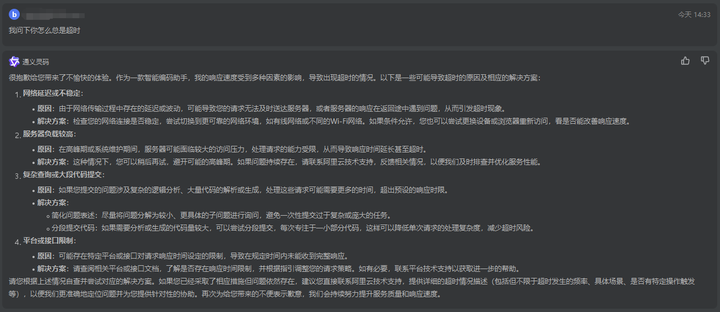
2、应加强上下文联动,尤其回答不够,需要“继续”时。
3、给出相应的提示词Demo,让程序员更快的了解专用的提示词。
4、增加文件上传对文件进行分析,然后根据要求修复代码或者,生成改写代码。
5、能够分析当前打开代码的语言和环境,能够快速识别,能够给使用者更好的体验。
怎么样今天的内容还满意吗?再次感谢观众老爷的观看。
最后,祝您早日实现财务自由,还请给个赞,谢谢!



















